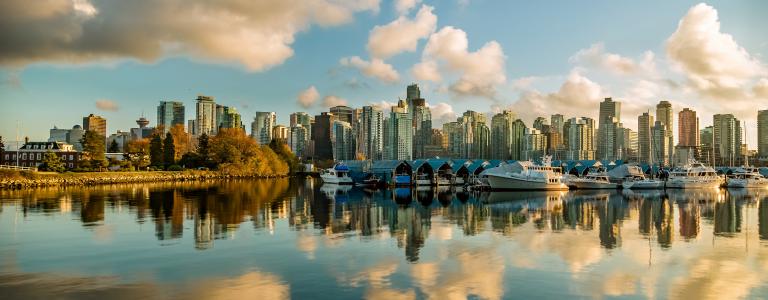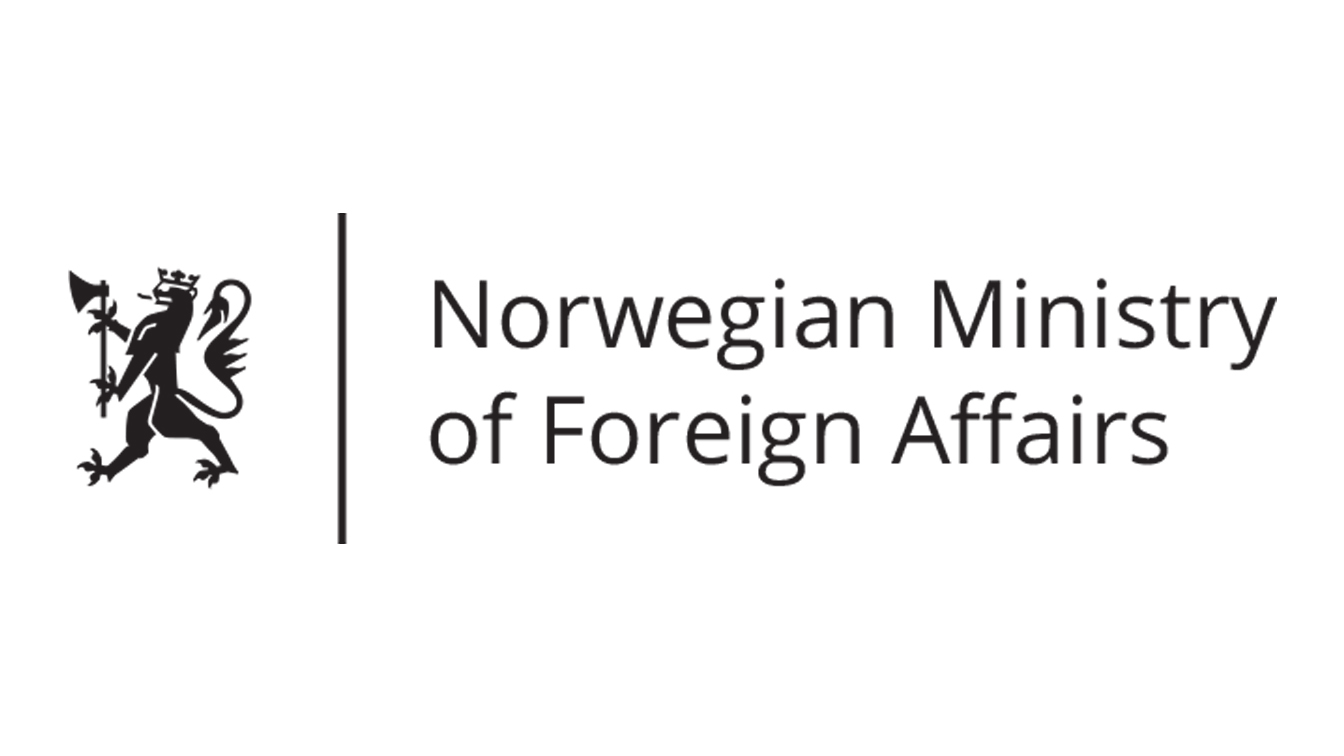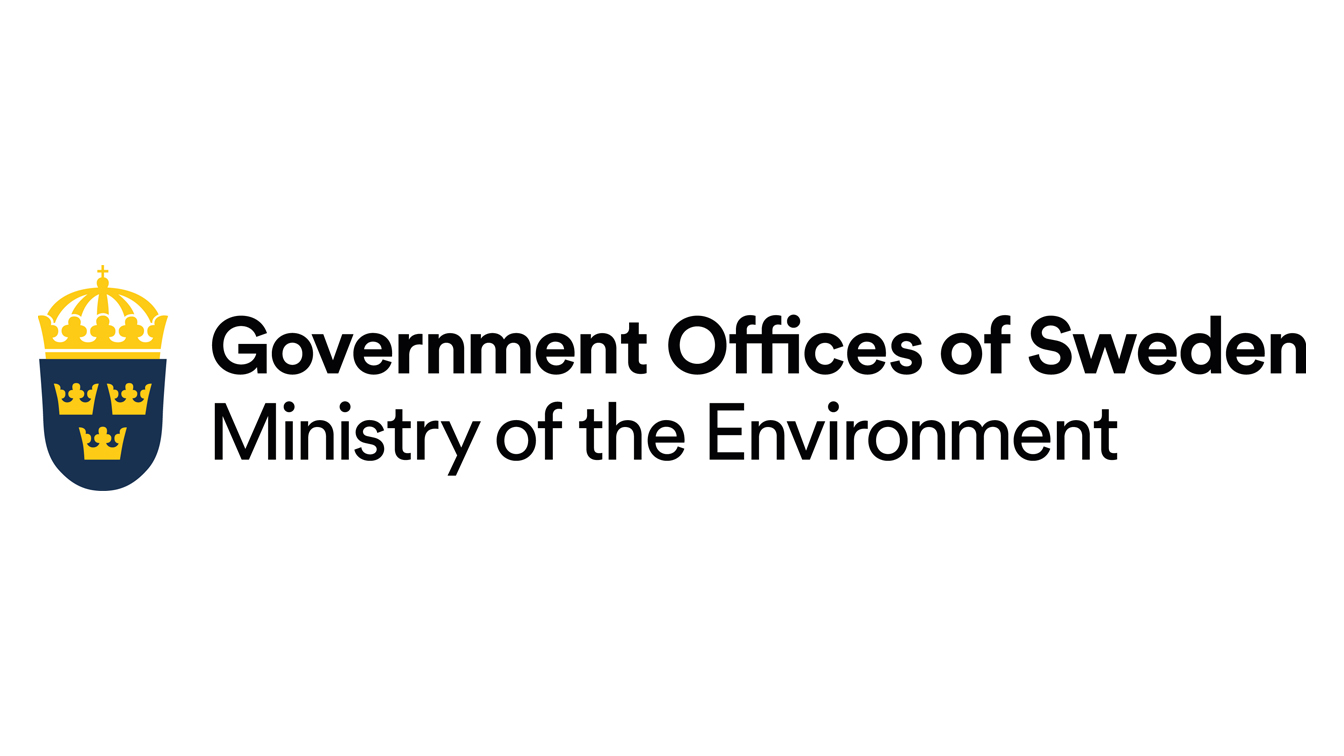Pathways to Sustainable Cities
Still Only One Earth: Lessons from 50 years of UN sustainable development policy
Most of the world’s population lives in urban areas, with the proportion projected to reach 68% by 2050. Increasing urbanization contributes to biodiversity loss, increased material consumption, and climate change. Moving forward, urban planning needs to be inclusive and responsive to the needs of local communities and build on participatory approaches that foster the engagement of marginalized actors while advancing access to basic services such as water and sanitation. Achieving sustainable cities requires overcoming barriers between different levels of government, attending to urban-rural linkages, and fostering decarbonization across the energy, transport, and building sectors. (Download PDF) (See all policy briefs) (Subscribe to ENB)
Urban sustainability initiatives regularly make headlines. Paris, France, for example has received much attention for new bike lanes and a generalized speed limit of 30 km/h for motorized traffic. Havana, Cuba, is famous for its urban agriculture; Curitiba, Brazil, is a pioneer in bus rapid transit systems; and Amsterdam, the Netherlands, is referred to as the world’s cycling capital.

Yet, often enough, when cities are featured in the news, headlines sound the alarm on the detrimental impacts of unsustainable urban development: Jakarta, Indonesia, is sinking; New Delhi, India, shut down schools amid high levels of air pollution; and residential buildings are collapsing due to lack of maintenance in Marseille, France. Recent reports highlight key figures, including:
- the proportion of the world’s population living in urban areas grew from 30% in 1950 to 55% in 2018 and is projected to reach 68% in 2050, with almost 90% of the projected increase to take place in Asia and Africa (UNDESA, 2019)
- in 2018, 24% of the global urban population lived in slums, often with limited access to basic services and with the proportion being as high as 56% in Sub-Saharan Africa (UNDESA, 2021)
- urban areas have more than doubled between 1992 and 2018, contributing to biodiversity loss (IPBES, 2019)
- cities are powerhouses of economic growth—contributing about 60% of global gross domestic product (GDP), but also account for a high percentage of global carbon emissions and natural resource use (UN, 2019)
- urbanization has exacerbated the impacts of global warming, with urban centres being warmer than their surrounding areas due to the urban heat island effect (IPCC, 2021)
Although sustainable urban development is receiving increased attention, the topic is not new. In fact, it was on the agenda of the very first multilateral environmental conference, the landmark 1972 United Nations Conference on the Human Environment in Stockholm, Sweden. At the time of the conference, which convened in the context of the decolonization process, urbanization was much lower, though growing. Policymakers nevertheless recognized urban sprawl has destructive impacts on the environment and that, while people move to urban areas with hopes of better employment opportunities and living conditions, cities often struggle to meet the increased demand for housing, mass transit, and other infrastructure. The question of how to ensure sustainable urban development has been on the global agenda ever since.
Planning must be applied to human settlements and urbanization with a view to avoiding adverse effects on the environment and obtaining maximum social economic and environmental benefits for all. In this respect, projects which are designed for colonialist and racist domination must be abandoned.
Selected Sustainable Urban Development Milestones
| 1972 | UN Conference on the Human Environment • Adopted the Stockholm Declaration, which featured a principle on sustainable urban development • Adopted the Stockholm Action Plan, which recommended the planning and management of human settlements for environmental quality • Recommended convening a thematically dedicated conference on human settlements |
| 1976 | First UN Human Settlements Conference (Habitat I) • Adopted the Vancouver Declaration and recommendations for national planning • Initiated the creation of the UN’s focal point for sustainable urbanization, the United Nations Commission on Human Settlements, an intergovernmental body, and its secretariat, the UN Centre for Human Settlements (commonly referred to as “Habitat”) |
| 1987 | “Our Common Future,” the report of the World Commission on Environment and Development • Featured a chapter on “The Urban Challenge,” which put into perspective urbanization challenges in the Global South and the Global North |
| 1992 | UN Conference on Environment and Development • Adopted Agenda 21, a program of action that featured a chapter on promoting sustainable human settlement development |
| 1996 | Second UN Human Settlements Conference (Habitat II) • Adopted the Habitat Agenda by which governments committed themselves to achieving the goals of adequate housing for all and sustainable human settlements, and which contains a global plan for action to support its implementation |
| 2015 | Sustainable Development Goals (SDGs) • The UN General Assembly adopted the SDGs that include a dedicated goal for sustainable urban development, SDG 11, which calls for making cities and human settlements inclusive, safe, resilient, and sustainable |
| 2016 | UN Conference on Housing and Sustainable Urban Development (Habitat III) • Adopted the New Urban Agenda, which sets out a 20-year action agenda |
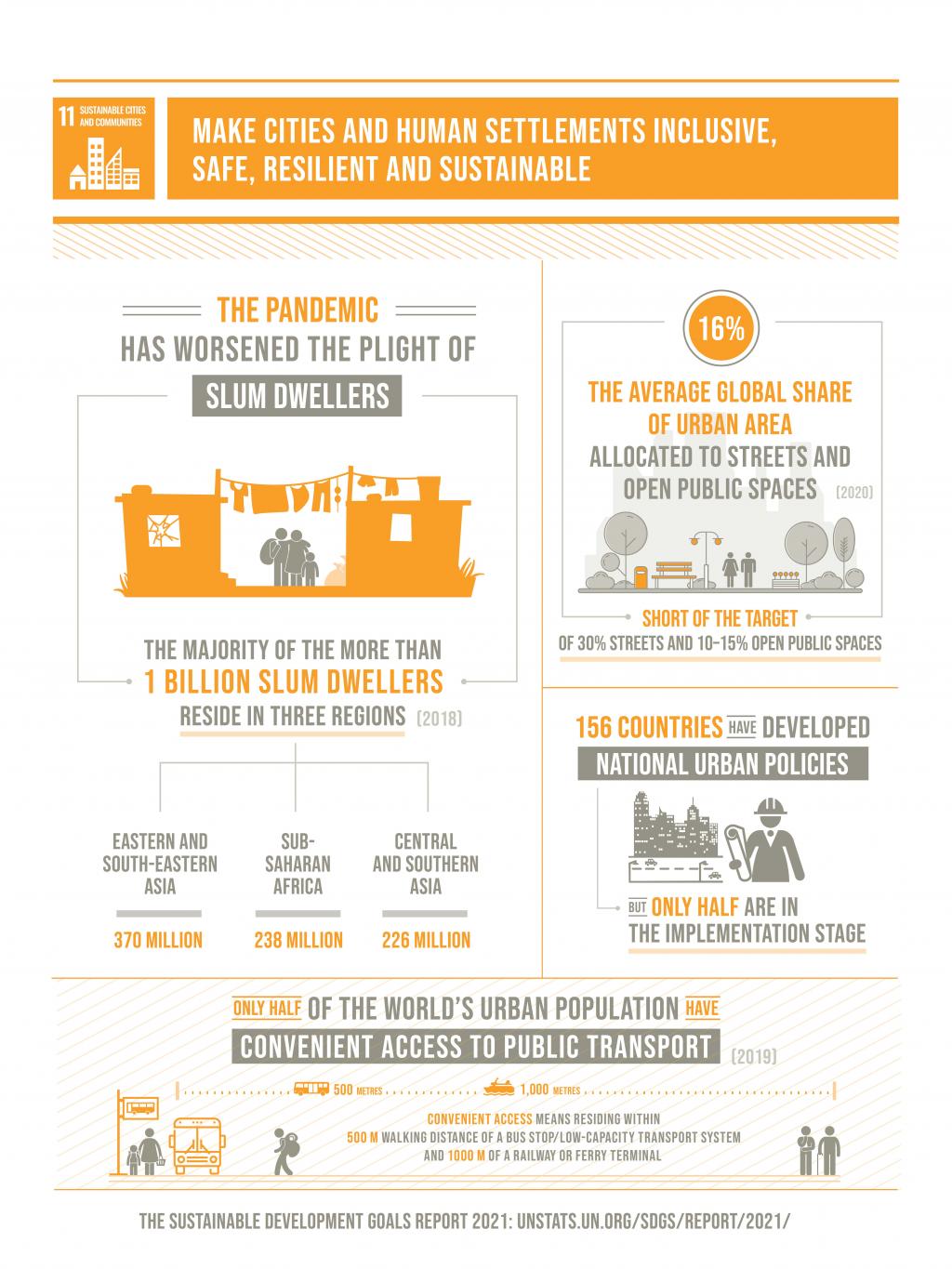
Multi-dimensional Issue
As set forth in the Vancouver Declaration adopted at the 1976 UN Human Settlements Conference (Habitat I), the most important objective of urban development policy is the improvement of the quality of life for all people, beginning with satisfying basic needs such as food, shelter, clean water, employment, health, and education. This objective has been reconfirmed throughout the years, including in the 2016 New Urban Agenda.
This underscores a fundamental reality: the starting line is not the same for all. Whereas fulfilling fundamental needs—such as through improving access to clean piped water and sanitation—remains an important part of urban planning in many cities of the Global South, discussions on sustainable cities in the Global North mainly centre on how to make existing infrastructure more efficient and less wasteful. In the latter, the aim is for a “transformation” of building, energy, transport, and other systems toward enhanced environmental sustainability—for example, promoting better building insulation for reduced heat waste or fostering waste recycling. As Youba Sokona, South Centre, and Vice-Chair of the Intergovernmental Panel on Climate Change (IPCC), recently noted, “In Africa the question is less about transformation and more about ‘jump starting’ their development in a sustainable manner.”
Beyond this stark global divide, there are significant differences within individual cities: higher-income neighborhoods are typically better serviced than low-income areas and some communities face discrimination that hampers the fulfillment of their fundamental needs. Life in Banana Island, one of Lagos, Nigeria’s gated communities, with wellmaintained roads and a central sewerage system, is vastly different from that in the nearby Makoko slum, where residents live under the threat of eviction and lack access to basic services (Ajayi et al., 2019). Roma people, Europe’s largest ethnic minority, continue to struggle with precarious housing and the US city of Flint, Michigan, whose African-American inhabitants suffered years of lead-poisoned water before a court confirmed wrongdoing, became the poster child of environmental racism. Today, discussions on ensuring access to basic services for all stand side-by-side with futuristic reflections on urban air mobility and drone-based delivery systems.
Sustainable urban development also spans various sectors, key among them housing, transportation, energy, water, waste, food, and health. But that’s not all. As multilateral declarations adopted over the past fifty years highlight, sustainable urban development also touches on heritage preservation, disaster planning, urban-rural linkages, and much more. Striving for sustainable cities requires a holistic vision for how to accommodate increasingly large urban populations, ensuring sustainable livelihoods, quality of life, and social cohesion, while minimizing cities’ and city dwellers’ immediate and long-term impact on the environment. Consequently, all challenges associated with the very notion of sustainability come to the fore in urban areas.
Finally, sustainable urban development is multi-dimensional because it spans a wide array of urban realities. Cities vary in size, with metropolises such as Manila, Philippines, or Beijing, China, having populations ten times larger than entire countries, such as Slovenia and Lesotho. These cities, which would rank among the top 60 most populous countries of the world, must deal with sustainable urban development challenges on a different scale than cities of little more than 50,000 inhabitants. And differences do not only relate to cities’ sizes, but also to factors such as their historical development and geographic location. Coastal cities must plan for sea level rise, while other cities might face water scarcity or must deal with an industrial downturn. There is no single recipe for sustainable urban development. It materializes differently, depending on cities’ specific contexts.
Urban Sustainability is Shaped by Many Actors
Local governments are the key players for fostering of urban sustainability as they can take measures within their own jurisdiction. They are also increasingly engaged in transnational networks, such as ICLEI – Local Governments for Sustainability and the C40 Cities Climate Leadership Group. These networks provide space for peer-learning among local governments from different countries and serve to feed urban perspectives directly into regional and global sustainability debates. But fostering sustainable cities is not only a matter for local governments. Other actors have power to steer cities toward sustainability.
For one, while the concrete allocation of authority differs between countries, actors at varying government levels have a role to play. National governments might set up an overall housing strategy with tax incentives for the development of new rental housing or pass legislation on insulation or energy efficiency, while cities can develop specific building codes and measures to support social housing. Others can also influence urban sustainability by adopting specific policies and standards, such as influencing norms or opening funding opportunities. This includes state, provincial, or regional governments in federally structured countries, supranational entities, where relevant, and multilateral fora.
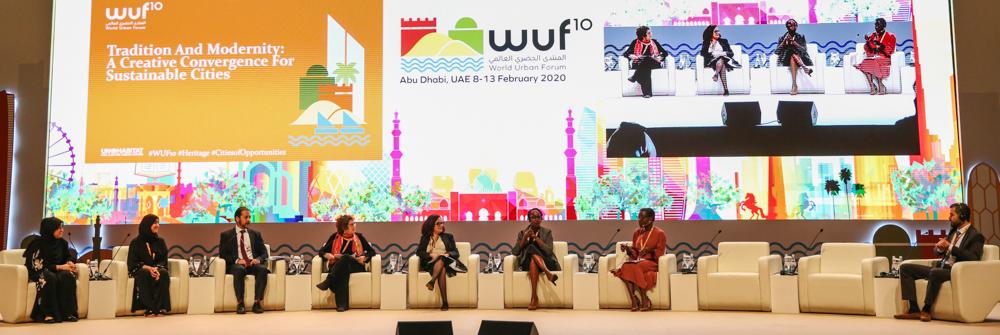
Further, non-governmental actors—including businesses, civil society organizations, schools, research institutions, and faith-based organizations—are also sustainability agents. They can self-govern toward sustainability, such as by adjusting diets in canteen menus or switching to renewable energy. At a larger scale, they can take outward-facing initiatives, such as hosting a repair café to help people fix broken household items and sharing information on grant programs for home retrofits, and pressure governments by lobbying for cities to phase out fossil fuels. Corporate initiatives toward enhanced urban sustainability can help develop new technologies and business models, with many leveraging big data and sharing economy approaches. Actors engage in sustainability initiatives for various reasons. As Westman et al. (2021) show, small- and medium-sized enterprises notably aim to improve their reputation in the local community, increase efficiency, or align with personal values. Some initiatives—such as when exasperated citizens build their own bike lanes—are disruptive and constitute a push for change from the bottom, while at other times windows of opportunity are opened from the top. Change often relies on the interplay between different kinds of actors, both governmental and non-governmental. Fostering urban sustainability nevertheless remains a protracted undertaking. Key challenges include that local governments at times lack the autonomy or fiscal and human capacity to undertake sustainability measures and that powerful actors—such as central governments or large businesses—might stand in the way of change (Beermann et al., 2016).
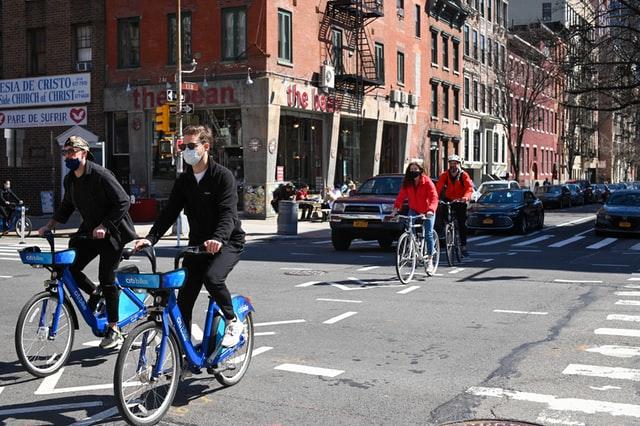
Key Trends in Sustainable Urban Development
Many new approaches to sustainable urban development are breaking with the long predominant mindset of “taming nature” and are bringing back greenery into the infamous concrete jungle. Think of urban agriculture, which is gaining ground in the collective imagery of sustainable cities.
More broadly, there is a strong move toward what is increasingly termed “nature-based solutions.” A look at urban water management provides many examples: New York City is restoring oyster reefs, cities like Seoul are daylighting water streams buried under concrete for many decades, and China is supporting the development of so-called sponge cities. Rather than relying only on hard engineering, these cities leverage natural infrastructure to achieve multiple benefits, not only enhancing flood management but also providing recreational opportunities and supporting biodiversity, among other benefits. Many such measures are designed to address climate change, especially from an adaptation and resilience standpoint. They can mitigate the urban heat island effect and flooding—both from increased precipitation events and, where relevant, storm surges. Plants are not only used on the ground and on roofs but also on facades, with architects and urban residents increasingly experimenting with vertical gardens. Similarly, urban wastelands and unused industrial infrastructure are being renatured to provide habitat for urban biodiversity and recreational spaces for city dwellers, with New York City’s High Line and Atlanta’s BeltLine in the US as flagship projects.
Cities are also grappling with the detrimental effects of decades of car-centred urban planning, which fostered urban sprawl, placed a barrier on other forms of transportation, contributed to a large share of cities’ greenhouse gas emissions, and lead to local air pollution (OECD, 2018). Multimodal transportation initiatives are sprouting up around the world in various forms, including: establishing toll roads (Singapore; London, UK), enabling free public transportation for residents (Aubagne, France; Tallinn, Estonia), installing cable cars (Medellín, Colombia; Constantine, Algeria), and giving priority traffic lights to cyclists as a default or when it rains (Odense, Denmark; Rotterdam, the Netherlands). Additionally, there are corporate initiatives such as bicycle and scooter rentals, and civil society actions, such as the collective bike rides of the Critical Mass movement. Most recently, the COVID-19 pandemic brought about a reckoning about the immense amount of urban space allocated to cars. In many cities, residents have become fond of newly extended sidewalks and parking spaces converted for outdoor dining. Whether this will truly bring about permanent change remains to be seen.
More fundamentally, equity considerations are increasingly coming to the fore, as people grapple with the fact that urban development has failed to make cities liveable for all. Building on the work of feminist and disability studies scholars, the World Bank (2020) provides a toolkit for redressing the fact that “In general, cities work better for heterosexual, able-bodied, cisgender men than they do for women, girls, sexual and gender minorities, and people with disabilities” (p. 8). Meehan et al. (2020) draw attention to intersecting social and racialized inequalities that curtail access to basic services, even in some of the most affluent cities in the world. This reckoning not only pertains to the detrimental effects of past urban planning, but also relates to more recent developments. For example, hostile architecture that has flourished in many places with the aim of banishing homeless people is increasingly decried as a manifestation of failures to address the root causes of homelessness and for rendering public spaces unwelcoming to urban dwellers at large. This critical reflection also relates to the potential negative effects of some sustainability measures, where green gentrification can increase local property values and displace existing residents who can no longer afford to live in the neighbourhood (Anguelovski, 2016).

Against this background, it is important to pay attention to inclusive urban planning. Decisions adopted at Habitat I in 1976 already stipulated that “Public participation is a right that must be accorded to all segments of the population, including the most disadvantaged” (p. 76) and that “Citizens must be provided opportunities for direct involvement in the decisions that profoundly affect their lives” (p. 71). This can foster democratic legitimacy and adapt measures to specific local contexts, which can enhance their effectiveness. Yet, as UN-Habitat (2019) notes, ensuring public participation in practice remains a challenge and “when deliberation occurs it is often biased towards more powerful stakeholders with greater resources” (p. 23). To overcome long-standing challenges with implementing participation ideals, scholars, community organizations, and some local governments are experimenting with different approaches, including participatory budgeting and community mapping exercises (Calisto Friant, 2019; Klopp & Cavoli, 2019).
As more and more people live in urban areas, coupled with worsening impacts from climate change and natural resource loss, the magnitude of the urban sustainability challenge and the need for decisive action is bigger than ever. As the world saw with the COVID-19 pandemic, overcrowding and poverty make it difficult to follow recommended measures such as social distancing and self-isolation. This calls for a holistic rethinking about how to make cities liveable for all while minimizing adverse impacts on the environment.
Striving for sustainable cities requires overcoming barriers between different levels of government as well as vested interests in preserving the status quo. It requires looking beyond the sphere of the urban to attend to urban-rural linkages, foster circular resource use, and decarbonize the energy, transport, and building sectors. Urban sustainability requires cross-sectoral planning and attention to the differentiated needs of all urban dwellers so as to leave no one behind in the necessary transformation. Sustainability pathways should be tailored to specific urban contexts. As such, there will never be one single model for what a sustainable city looks like.
Works Consulted
Ajayi, O., Soyinka-Airewele, P., & Samuel, O. (2019). Gentrification and the challenge of development in Makoko, Lagos State, Nigeria: A rights-based perspective. Environmental Justice, 12(2), 41-47. doi.org/10.1089/env.2018.0020
Anguelovski, I. (2015). From toxic sites to parks as (green) LULUs? New challenges of inequity, privilege, gentrification, and exclusion for urban environmental justice. Journal of Planning Literature, 31(1), 23-36. doi.org/10.1177/0885412215610491
Beermann, J., Damodaran, A., Jörgensen, K., & Schreurs, M. A. (2016). Climate action in Indian cities: An emerging new research area. Journal of Integrative Environmental Sciences, 13(1), 55-66. doi.org/10.1080/1943815x.2015.1130723
Calisto Friant, M. (2019). Deliberating for sustainability: Lessons from the Porto Alegre experiment with participatory budgeting. International Journal of Urban Sustainable Development, 11(1), 81-99. doi.org/10.1080/19463138.2019.1570219
Intergovernmental Panel on Climate Change. (2021). Regional fact sheet - urban areas. Sixth Assessment Report. Working Group I - The Physical Science Basis. ipcc.ch/report/ar6/wg1/downloads/factsheets/IPCC_AR6_WGI_Regional_Fact_Sheet_Urban_areas.pdf
Intergovernmental Science-Policy Platform on Biodiversity and Ecosystem Services. (2019). Summary for policymakers of the global assessment report on biodiversity and ecosystem services of the Intergovernmental Science-Policy Platform on Biodiversity and Ecosystem Services. S. Díaz, J. Settele, E. S. Brondízio E.S., H. T. Ngo, M. Guèze, J. Agard, A. Arneth, P. Balvanera, K. A. Brauman, S. H. M. Butchart, K. M. A. Chan, L. A. Garibaldi, K. Ichii, J. Liu, S. M. Subramanian, G. F. Midgley, P. Miloslavich, Z. Molnár, D. Obura, A. Pfaff, S. Polasky, A. Purvis, J. Razzaque, B. Reyers, R. Roy Chowdhury, Y. J. Shin, I. J. Visseren-Hamakers, K. J. Willis, and C. N. Zayas (Eds.). ipbes.net/sites/default/files/inline/files/ipbes_global_assessment_report_summary_for_policymakers.pdf
Klopp, J. M., & Cavoli, C. (2019). Mapping minibuses in Maputo and Nairobi: Engaging paratransit in transportation planning in African cities. Transport Reviews, 39(5), 657-676. doi.org/10.1080/01441647.2019.1598513
Meehan, K., Jurjevich, J. R., Chun, N. M. J. W., & Sherrill, J. (2020). Geographies of insecure water access and the housing–water nexus in US cities. Proceedings of the National Academy of Sciences, 117(46), 28700-28707. doi.org/10.1073/pnas.2007361117
Organisation for Economic Co-operation and Development. (2018). Rethinking urban sprawl: Moving towards sustainable cities. doi.org/10.1787/9789264189881-en
UN-Habitat. (2019). Mixed reality for public participation in urban and public space design: Towards a new way of crowdsourcing more inclusive smart cities. unhabitat.org/mixed-reality-for-public-participation-in-urban-and-public-spacedesign-towards-a-new-way-of
United Nations. (2019). The Sustainable Development Goals report 2019. unstats.un.org/sdgs/report/2019/
United Nations. (2021). The Sustainable Development Goals report 2021. unstats.un.org/sdgs/report/2021/
United Nations Department of Economic and Social Affairs. (2019). World urbanization prospects: The 2018 revision. population. un.org/wup/Publications/Files/WUP2018-Report.pdf
UN-Water. (2021). Summary progress update 2021: SDG 6 – water and sanitation for all. unwater.org/publications/summary-progress-update-2021-sdg-6-water-andsanitation-for-all/
Westman, L., Luederitz, C., Kundurpi, A., Mercado, A. J., Weber, O., & Burch, S. L. (2018). Conceptualizing businesses as social actors: A framework for understanding sustainability actions in small- and medium-sized enterprises. Business Strategy and the Environment, 28(2), 388-402. doi.org/10.1002/bse.2256
World Bank. (2020). Handbook for genderinclusive urban planning design. worldbank.org/en/topic/urbandevelopment/publication/handbook-for-gender-inclusive-urban-planning-and-design
Additional downloads
You might also be interested in
Web of resilience
Pakistan's development model has still not recognised the limits of the natural environment and the damage it would cause, if violated, to the sustainability of development and to the health and well-being of its population. Pakistan’s environment journey began with Stockholm Declaration in 1972. A delegation led by Nusrat Bhutto represented the country at the Stockholm meeting, resulting in the establishment of the Urban Affairs Division (UAD), the precursor of today’s Ministry of Climate Change. In setting the country’s environmental agenda, we were inspired by the Stockholm Principles, but in reality, we have mostly ignored them for the last five decades.
What Will Happen at COP 29?
Talks at the 2024 UN Climate Change Conference (COP 29) will range from defining a way forward on finance through a new collective quantified goal (NCQG) to mitigation, and loss and damage. Ahead of negotiations in Baku, IISD’s Earth Negotiations Bulletin Team Lead Jennifer Bansard examines the agenda and breaks down what to watch as eyes turn to Azerbaijan.
A Warming Arctic is a Warning for the World
To protect the Arctic, stronger and broader local, national, and international measures to reduce greenhouse gas emissions must be implemented.
The Water and Sanitation Challenge
For universal access to water to become a reality, governments and private-sector service providers should adopt a human rights-based approach to ensure water and sanitation services are safe, available, accessible, affordable, and culturally acceptable.
